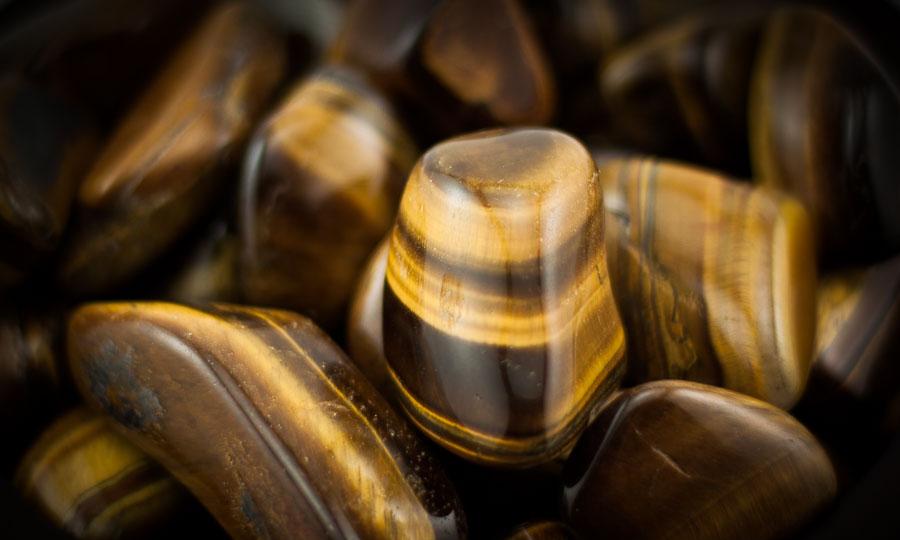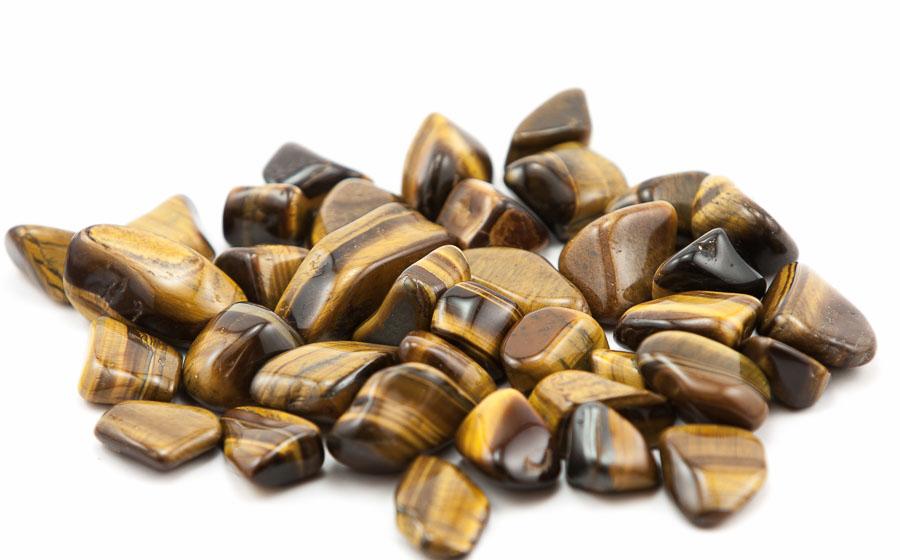You will not be allowed to compare more than 4 products at a time
View compareTigers Eye Tumbled 1 lb
Tigers Eye Tumbled 1 lb
Estimate delivery times:5-8 days.
Flat Rate Shipping and FREE Shipping on orders more than $100.
About This Product
Tiger’s Eye – The Stone of Courage, Focus, and Golden Power
Introduction
Tiger’s Eye is a mesmerizing variety of quartz renowned for its golden to reddish-brown color and silky luster. When light strikes this stone, it ignites a captivating chatoyancy – a cat’s-eye effect – appearing as shimmering bands that glide across the surface as the stone or observer moves. This optical dance comes from Tiger’s Eye’s fibrous structure: parallel rows of microscopic fibers that reflect light in unison. The result is a wavy, satiny sheen that seems almost alive, giving the stone an inner glow and depth. With its striking stripes and dynamic glow, Tiger’s Eye truly lives up to its legendary namesake, radiating an aura of warmth and vitality.
Historical and Cultural Background
Throughout history, Tiger’s Eye has been cherished as a powerful and protective talisman. In ancient Egypt it was inlaid into deity statues as the eyes, symbolizing the gods’ all-seeing, divine vision and blending the protective energies of the sun god Ra with the earth god Geb. Roman soldiers famously carried engraved Tiger’s Eye amulets into battle, believing the stone would deflect weapons and bolster their courage in combat. Many cultures also revered Tiger’s Eye as an “all-seeing” stone of luck and protection – thought to guard one’s resources and reflect back any malice or curses cast by others.
In Eastern traditions, Tiger’s Eye is closely linked to the tiger – the powerful king of beasts – and embodies courage, integrity, and balance. In China, its golden-brown bands are seen as reflections of yin and yang harmony, and it is used in Feng Shui to invite wisdom, strength, and good luck into homes. The stone’s watchful quality also made it a popular charm against the “evil eye” across Asia and the Middle East, believed to ward off malevolent glances and protect the wearer from misfortune. From ancient battlefields to temple altars, Tiger’s Eye has been valued as a symbol of protection and prosperity that bridges the earthly and the divine.
Metaphysical Symbolism
Tiger’s Eye is celebrated not only for its beauty but also for the energetic qualities it is believed to bestow on its holder. In crystal lore, this gemstone resonates strongly with personal power and balance:
-
Courage & Confidence: Often called the “stone of courage,” Tiger’s Eye empowers one to overcome fear. It radiates confidence and inner strength, helping to instill bravery and bolster self-confidence in the face of challenges. By instilling courage and clarity, it helps overcome self-doubt and ignites an unwavering determination to move forward.
-
Focus & Mental Clarity: Tiger’s Eye has a grounding energy that promotes sharp focus and clear thinking. It helps channel scattered thoughts into a centered state, providing clarity of mind for wise decision-making. Many find that it brings a “tiger’s-eye” perspective – the ability to see truth without illusion – enhancing concentration and perception.
-
Grounding & Balance: With its connection to both earth and sun energies, Tiger’s Eye is said to balance extremes. It carries a grounding vibration that anchors chaotic emotions, promoting equilibrium in one’s energy. This stone is thought to harmonize yin-yang forces, keeping you centered and calm yet invigorated. The result is a balanced mood and steady resolve, even amid upheaval.
-
Protection: Long esteemed as a protective amulet, Tiger’s Eye is believed to shield its wearer from negativity. Its vigilant “all-seeing eye” reputedly deflects ill wishes, curses, or psychic attacks, reflecting back harm to its source. Keeping Tiger’s Eye close is thought to surround one in an energetic barrier of protection, guarding one’s aura and bringing a sense of security.
-
Personal Empowerment (Solar Plexus Chakra): Associated with the solar plexus chakra, Tiger’s Eye stimulates one’s personal power, willpower, and ambition. It promotes self-assurance and decision-making, aiding in asserting your personal will. By resonating with this chakra of confidence and drive, Tiger’s Eye helps awaken your inner warrior – empowering you to pursue goals with enthusiasm and faith in your abilities. This leads to heightened mental clarity, creativity, and confidence, fueling personal growth and transformation.
Decorative and Luxury Appeal
The distinctive beauty of Tiger’s Eye gives it a broad appeal in both metaphysical circles and high-end design. Jewelers and artisans love to showcase its chatoyant glow by shaping the stone into smooth cabochons for rings, pendants, and earrings, or into round beads for necklaces and bracelets. When polished and set in precious metals, the stone’s rich golden-brown bands stand out elegantly – it pairs especially well with yellow gold or sterling silver, creating a warm, sophisticated contrast. Because Tiger’s Eye is typically cut en cabochon (with a rounded top) to maximize its light effect, even small pieces exhibit the sought-after cat’s eye shimmer. From vintage men’s cufflinks to modern statement jewelry, Tiger’s Eye adds an earthy yet luxurious touch that attracts both collectors and fashion enthusiasts. Its affordability and durability also mean it appears in everything from costume jewelry to bespoke designer pieces, bridging the gap between everyday wear and upscale adornment.
Beyond jewelry, Tiger’s Eye is popular for decorative objects and collectibles. Artisans carve this stone into sculptures, figurines, spheres, and obelisks, which make eye-catching decor accents and spiritual tools. Polished Tiger’s Eye spheres are often used in Feng Shui placements or meditation spaces, believed to radiate protective, balancing energy throughout a room. Tumbled Tiger’s Eye stones are common in crystal collections – their silky shine and banded patterns are perfect for display in bowls or grids. In luxury interiors, designers have even used Tiger’s Eye in inlays, mosaics, and tabletops, capitalizing on its vibrant stripes to add natural elegance. Whether used as a feng shui talisman for its spiritual benefits or as a stunning ornamental piece for its aesthetic charm, Tiger’s Eye’s versatility shines. It effortlessly complements both bohemian crystal decor and high-end artistic designs, making it a beloved material for those who appreciate beauty with a bit of mystique.
Scientific Profile
Even from a scientific and gemological perspective, Tiger’s Eye has fascinating characteristics that set it apart. Below is a breakdown of its key properties:
-
Chemical Composition: Silicon dioxide (SiO₂), the same composition as quartz. Tiger’s Eye is essentially quartz infused with iron-rich fibers, which give it its color and chatoyancy.
-
Crystal System: Trigonal (microcrystalline quartz). It belongs to the quartz family, meaning its crystal structure is hexagonal/trigonal, though Tiger’s Eye forms as intergrown fibrous layers rather than large single crystals.
-
Mohs Hardness: ~6.5 to 7 on the Mohs scale. It is relatively hard and capable of scratching glass, making it suitable for durable jewelry.
-
Luster: Silky when polished. The finest Tiger’s Eye gems have a silk-like sheen due to light reflecting off parallel fibers, whereas lower grades may appear more vitreous (glassy).
-
Transparency: Typically opaque, sometimes semi-translucent in thin slivers. Most Tiger’s Eye stones do not transmit light except around the edges or in very thin pieces, due to dense fibrous structure and iron content.
-
Cleavage & Fracture: No cleavage (like all quartz) and a conchoidal fracture. When broken, it tends to chip with curved, shell-like surfaces or splintery edges. This lack of cleavage is an identifying feature distinguishing it from some layered look-alike minerals.
-
Habit and Formation: Occurs as a pseudomorph – originally fibrous blue crocidolite (asbestos) that has been replaced by quartz over time. The resulting stone retains the fibrous texture of the original mineral. Iron oxides (like limonite/goethite) incorporated during this replacement give Tiger’s Eye its brown-yellow coloration. Essentially, Tiger’s Eye is the outcome of quartz slowly infiltrating and overtaking asbestos fibers, fossilizing their structure.
-
Chatoyancy Origin: Tiger’s Eye’s trademark chatoyancy (cat’s-eye effect) is caused by its aligned fibrous bands and alternating layers of quartz and iron oxides. Light reflecting off these parallel fibers produces a single bright band of light that shifts position as the stone is rotated. In Tiger’s Eye (sometimes called “silk quartz”), the fibers are slightly wavy, so the cat’s-eye line may appear as multiple close bands rather than one razor-sharp line, distinguishing it from the singular eye of gems like chrysoberyl.
-
Color Variations: Classic Tiger’s Eye is golden to deep brown, colored by iron oxide staining. There are also other natural variants: blue Tiger’s Eye, known as Hawk’s Eye, forms when the quartz replacement of crocidolite is incomplete, leaving a bluish-gray hue with the same chatoyancy. Additionally, gentle heat treatment (either natural or artificial) can turn brown Tiger’s Eye a rich red color by altering the iron oxides. These red Tiger’s Eye stones (sometimes called “bull’s eye”) are often created by heating golden Tiger’s Eye. All color varieties display the silky bands, whether honey-gold, reddish, or steel-blue.
-
Primary Sources: The most significant deposits of Tiger’s Eye are found in South Africa, especially the Northern Cape Province, and in Western Australia. These two regions have produced the bulk of the world’s Tiger’s Eye on the market. Other notable sources include Namibia, India, Myanmar (Burma), Brazil, Canada, and the United States. In the US, Tiger’s Eye (and similar chatoyant stones) have been found in states like Arizona and California, though in much smaller quantities.
-
Identifying Traits: Tiger’s Eye is easily recognized by its iridescent, banded appearance and moving light streak (chatoyancy). Under a single light source, you’ll see a silky stripe of light sweep across the stone’s surface. Unlike true “cat’s eye” gems (e.g. chrysoberyl) that show one sharp eye, Tiger’s Eye usually shows a broader series of parallel shimmering lines. Its combination of Quartz hardness (no scratching with a knife, about 7 Mohs), lack of cleavage, and the unique golden-brown stripes helps differentiate Tiger’s Eye from look-alikes or glass imitations. Many fakes can be identified because they won’t exhibit the moving eye effect as distinctly, or they may be softer. Real Tiger’s Eye will feel weighty for its size (specific gravity ~2.64–2.71) and often shows natural variations of brown, gold, and sometimes red or blue bands in one piece. Together, these traits make Tiger’s Eye one of the most recognizable and intriguing gemstones among collectors and gemologists alike.
Sub total:
$36.49





